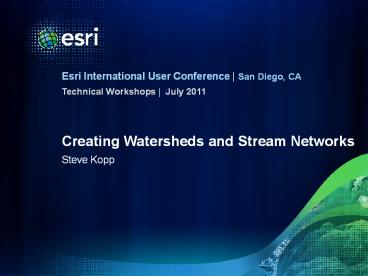Creating Watersheds and Stream Networks - PowerPoint PPT Presentation
Title: Creating Watersheds and Stream Networks
1
Creating Watersheds and Stream Networks
- July 2011
- Steve Kopp
2
Elevation Data
- Types
- DEM Digital Elevation Model bare Earth
- DSM Digital Surface Model
- Data Structure
- Raster
- TIN
- Terrain
3
Where do you get DEM data?
- Sources http//seamless.usgs.gov/
- Global
- GTOPO30 - 1 km
- SRTM - 90m
- ASTER - 30m
- United States NED 30m and 10 m
- LiDAR, IfSAR
- Generated photogrammetrically
- Created with interpolation tools
- especially TopoToRaster
4
DEM Construction Considerations
- Extent
- Map Projection (use equal area)
- Cell size and Resolution
- Must be appropriate for the landscape and scale
being modeled. - Source elevation data (accuracy, density,
sampling) - Interpolation techniques (use TopoToRaster)
- Special consideration for contour input
- TopoToRaster interpolator works well with
contours, creates hydrologically correct DEM
5
Drainage System
Watershed (Basin, Catchment, Contributing area)
Watershed Boundaries (Drainage Divides)
Pour Points (Outlets)
6
Function Processing
7
Hydrologically Correct DEM
- Sinks
- Some sinks are real
- Do not fill in the Great Salt Lake
- Streams in the correct place?
- To burn or not to burn
- Watershed boundaries in the correct place?
- To fence or not to fence
8
DEM Errors Sinks and Spikes
- Sinks when sinks are (or are not) sinks
- E.g. Lakes, depressions, karst and glacial
landscapes - Global fill
- Dealing with internal basins
- Selective fill
- Depth
- Area
9
Flow Direction
Flow Direction
Elevation
Direction Coding
10
Flow Accumulation
Direction Coding
11
Function Processing
12
Creating Vector Streams
Value No Data
StreamToFeature
RasterToFeature
13
Stream Link
- Assign a unique value to each stream segment.
- Can be used as input to Watershed tool
14
Stream Ordering
Shreve
Strahler
15
Watershed Delineation
- Delineate the contributing area to a cell or
group of cells.
16
Snapping Pour Points
- Use the SnapPour tool to snap the pour point of
a watershed to the cell of highest flow
accumulation within a neighborhood. - Prevents accidental creation of tiny watersheds
on channel side slopes.
17
Flow Length
- Calculate the length of the upstream or
downstream flow path from each cell.
18
Where is this functionality?
- Tools in the Spatial Analyst Toolbox
- Sample ModelBuilder model on the Geoprocessing
Resource Center - Arc Hydro data model tools
http//resources.arcgis.com/content/hydro
19
Questions Answers
Please fill out the session evaluation
formswww.esri.com/sessionevals
Thank you
20
Summarizing Watershed Characteristics
- Use the Zonal Statistics tool
- A zone is all the areas/cells with the same
value - Calculate a statistic within the zones for each
cell in a raster - Input zones can be feature or raster
- Output as a raster, summary table, or chart
- Max flow length per watershed
- Average slope per watershed
- Average curve number per watershed
21
Summarizing Watershed Characteristics
- Using the Zonal Statistics tool
Slope

